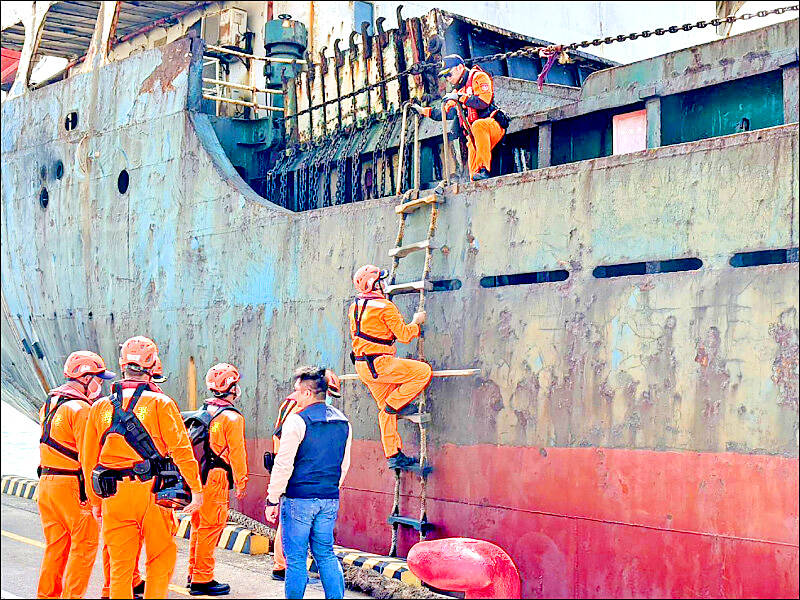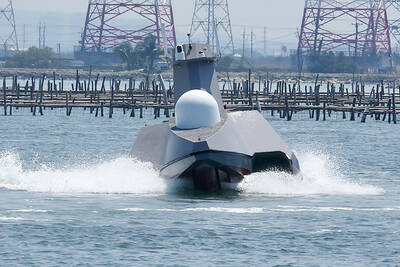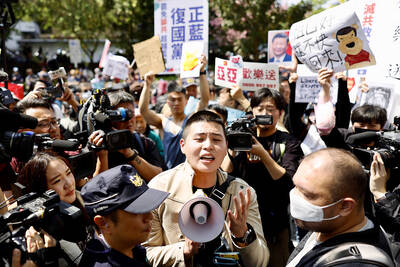A Chinese freighter that allegedly snapped an undersea cable linking Taiwan proper to Penghu County is suspected of being owned by a Chinese state-run company and had docked at the ports of Kaohsiung and Keelung for three months using different names.
On Tuesday last week, the Togo-flagged freighter Hong Tai 58 (宏泰58號) and its Chinese crew were detained after the Taipei-Penghu No. 3 submarine cable was severed.
When the Coast Guard Administration (CGA) first attempted to detain the ship on grounds of possible sabotage, its crew said the ship’s name was Hong Tai 168, although the Automatic Identification System (AIS) displayed it as Hong Tai 58, the CGA said.

Photo courtesy of the Coast Guard Administration
The ship’s name would be verified by an investigation, the CGA said.
A review of AIS records by the Chinese-language Liberty Times (Taipei Times’ sister paper) showed that the freighter Hong Tai in September had visited the harbors of Kaohsiung, Anping, Keelung and South Korea’s Busan.
The freighter apparently turned off its AIS some time after that.
In January, the freighter re-engaged its AIS and appeared in waters near the Port of Kaohsiung and the device stayed on until 11am on Thursday, when the CGA brought the ship to the Port of Anping.
The records showed the Hong Tai had two International Maritime Organization identification numbers, which breaches the agency’s rules.
Also, the freighter’s Maritime Mobile Service Identities (MMSI) identification number had been used by the Tanzania-flagged Hong Da 8 (宏大8號) and China-flagged Jin Long 389 (金龍389號).
The Jin Long 389’s transponder has remained silent for years and the Hong Da 8, which is active, has operated with three MMSI numbers.
The records suggested that Hong Tai 58, Hong Da 8 and Jin Long 389 were the same freighter.
Chinese state-run China COSCO Shipping Corp (中國遠洋海運集團) and Guangdong-based Jin Long Maritime Transport (金龍航運) owned and operated the Jin Long 389, the records showed.
The Hong Tai 58 was linked through its MMSI numbers to six vessels.
Five of the ships sailed between Taiwan, China and South Korea in the past three months, each using their AIS, but intermittently.
The Hong Da 8 had entered the Port of Anping as recently as Feb. 2.
Experts yesterday said the CGA should be applauded for its swift response, but each cable-cutting incident was a blow to national security and government finance.
Taiwan must come up with a strategy to prevent further attempts to sabotage submarine cables, they added.
The government should track ships that have engaged in suspicious activities, and it should cooperate with friendly nations in maritime matters, Democratic Progressive Party Legislator Puma Shen (沈伯洋) said.
Shared intelligence would enable the government to name the suspected ships and bring pressure on Beijing, he said.
Taiwan should strengthen its use of intelligence-gathering assets and coast guard patrol ships, and severely punish saboteurs to deter Chinese crews, Institute for National Defense and Security Research fellow Shen Ming-shih (沈明室) said.
The government should obtain more rotary and low-speed fixed-wing aircraft configured for maritime surveillance, and increase multi-agency collaboration efficiency, he said.
Additional reporting by CNA

ENDEAVOR MANTA: The ship is programmed to automatically return to its designated home port and would self-destruct if seized by another party The Endeavor Manta, Taiwan’s first military-specification uncrewed surface vehicle (USV) tailor-made to operate in the Taiwan Strait in a bid to bolster the nation’s asymmetric combat capabilities made its first appearance at Kaohsiung’s Singda Harbor yesterday. Taking inspiration from Ukraine’s navy, which is using USVs to force Russia’s Black Sea fleet to take shelter within its own ports, CSBC Taiwan (台灣國際造船) established a research and development unit on USVs last year, CSBC chairman Huang Cheng-hung (黃正弘) said. With the exception of the satellite guidance system and the outboard motors — which were purchased from foreign companies that were not affiliated with Chinese-funded

PERMIT REVOKED: The influencer at a news conference said the National Immigration Agency was infringing on human rights and persecuting Chinese spouses Chinese influencer “Yaya in Taiwan” (亞亞在台灣) yesterday evening voluntarily left Taiwan, despite saying yesterday morning that she had “no intention” of leaving after her residence permit was revoked over her comments on Taiwan being “unified” with China by military force. The Ministry of the Interior yesterday had said that it could forcibly deport the influencer at midnight, but was considering taking a more flexible approach and beginning procedures this morning. The influencer, whose given name is Liu Zhenya (劉振亞), departed on a 8:45pm flight from Taipei International Airport (Songshan airport) to Fuzhou, China. Liu held a news conference at the airport at 7pm,

AIR SUPPORT: The Ministry of National Defense thanked the US for the delivery, adding that it was an indicator of the White House’s commitment to the Taiwan Relations Act Deputy Minister of National Defense Po Horng-huei (柏鴻輝) and Representative to the US Alexander Yui on Friday attended a delivery ceremony for the first of Taiwan’s long-awaited 66 F-16C/D Block 70 jets at a Lockheed Martin Corp factory in Greenville, South Carolina. “We are so proud to be the global home of the F-16 and to support Taiwan’s air defense capabilities,” US Representative William Timmons wrote on X, alongside a photograph of Taiwanese and US officials at the event. The F-16C/D Block 70 jets Taiwan ordered have the same capabilities as aircraft that had been upgraded to F-16Vs. The batch of Lockheed Martin

GRIDLOCK: The National Fire Agency’s Special Search and Rescue team is on standby to travel to the countries to help out with the rescue effort A powerful earthquake rocked Myanmar and neighboring Thailand yesterday, killing at least three people in Bangkok and burying dozens when a high-rise building under construction collapsed. Footage shared on social media from Myanmar’s second-largest city showed widespread destruction, raising fears that many were trapped under the rubble or killed. The magnitude 7.7 earthquake, with an epicenter near Mandalay in Myanmar, struck at midday and was followed by a strong magnitude 6.4 aftershock. The extent of death, injury and destruction — especially in Myanmar, which is embroiled in a civil war and where information is tightly controlled at the best of times —